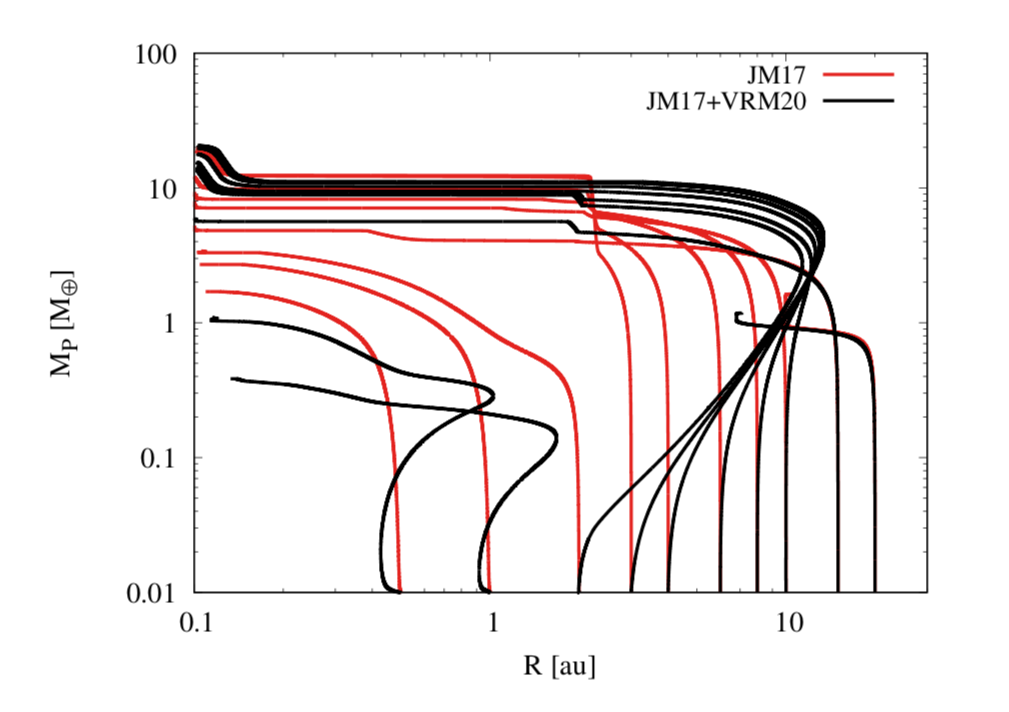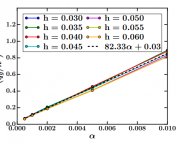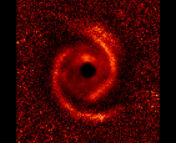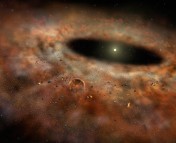Title: The importance of thermal torques on the migration of planets growing by pebble accretion
Authors: O. M. Guilera, M. M. Miller Bertolami, F. Masset, J. Cuadra, J. Venturini, M. P. Ronco
First Author’s Institution: Instituto de Astrofísica de La Plata, CONICET-UNLP, La Plata, Argentina
Paper Status: Accepted to MNRAS [open access]
If you were the universe, and you needed to bake a rocky ball, what would you use? Usually, when we try to make a popcorn ball, we paste together sticky popcorn until the whole mass becomes massive and spherical enough. But if you were the universe, you wouldn’t have large enough things to stick together, so you would need to use what you have: tiny particles and gas. This is how rocky cores form from the accretion of small particles of negligible gravitational mass (we call them pebbles) onto large gravitating bodies. Large gravitational bodies, also called planetesimals, protoplanets, and planets, are all massive enough for their gravity to attract pebbles. Both gas drag and gravity play an important role in the pebble accretion process.
However, while forming, a planet also exchanges an angular momentum and torque with a protoplanetary disk. This exchange makes the planet move, or as we call it, migrate from its initial position. In today’s paper, the authors discuss the migration of planets growing by pebble accretion.
When a planet and a disk interact, some total (net) torque causes the migration of a planet. This total torque consists of several torques, and the authors of today’s paper focus on the thermal torque. This is the torque due to a planet being a luminous object, which releases heat into the surrounding disk. The authors of the paper investigate the importance of this thermal torque in planetary migration and show that the migration and the final planet masses can be different depending on whether or not the thermal torque is included.
Inward or outward?
Figure 1 shows the evolution of a planet’s semi-major axis (horizontal) and mass (vertical). The semi-major axis shows how a planet migrates: if the line goes to the right, then the planet migrates outward (its semi-major axis becomes longer), if the line goes to the left, then the planet migrates inward (its semi-major axis becomes shorter). By looking at the lines in Figure 1, you can also see how the planetary mass increases – well, the planet is getting formed!
One of the important results is that if the thermal torque is not included, the red lines show that for planets initially located beyond 2 AU (ice line region), the planets grow faster to larger core masses, and, when they reach the ice line, they “eat” solids from the ice line and migrate inwards. The concept of the ice line becomes important here, because this is the region where the dust properties change. For the models where the thermal torque is considered (the black lines), the planets that are located closer (first two black lines on the left) first migrate inward but then quickly start migrating outward due to the thermal torque, and then, after becoming closer to the ice line, they migrate inward again! For the planets initially located beyond the ice line (except for the two outermost ones), and the one located just inside it, at 2 AU, they significantly migrate outward due to the thermal torque. Then, the outward migration is reversed and the planets migrate inward. However, though planet migration is quite different, the final masses and semi-major axes end up being similar, despite the consideration of thermal torques.

What if we give planets more food?
Figure 2 shows the formation track of a planet in a more massive disk. Looking at the black curves, they show the simulations that consider thermal torques. Most of these black curves show the inward migration until the planets reach the disk’s inner edge (<1 AU). When the thermal torque is considered, planets initially migrate inward more efficiently, but inward migration is quickly reversed by the thermal torque (the black lines are highly tilted!). For example, the planet initially located at 2 AU migrates outward until about 15 AU crossing the ice line, and ends with a final mass of ∼ 10 Earth masses. In this case, not only the final mass of the planets is very different with respect to the runs without the thermal torque, but also the final composition differs significantly – planets are more massive, which means they might have accreted more pebbles. When the thermal torque is not considered (red lines), the planets just migrate inward and end with a dry composition after accreting ∼ 3 Earth masses of dry pebbles. When the thermal torque is taken into account, most of the mass of the planet is accreted beyond the ice line (the planet crosses the ice line when it has about the mass of Mars), ending as a water-rich planet.
To investigate what happens not only if the disk is more massive but also has more solids, the authors run other simulations (look at Figure 3). The authors made a set of runs with a fixed initial metallicity of the disk – now the disk has three times more solids. For the case where the thermal torque is considered, planets efficiently migrate outward until about 20 AU, at which point their migration is reversed. For the case where the thermal torque is not considered, the migration is strictly inward.


The thermal torque is an important contribution to the total torque over a migrating planet, especially if the planet grows by pebble accretion. As this work showed, it can change a planet’s mass, semi-major axis, and composition. The work also shows that the thermal torque is particularly important for massive disks and high metallicities, as it completely reverses the direction of migration. Studying the migration of planets is important for planet formation, because planets don’t stay in their positions for too long!
Astrobite edited by: Jason Hinkle
Featured image credit: Singing Planets





This is very interesting. As a matter of fact there is also a similar blog that also talks about the thermal torque and planets. I have also some interesting blogs that you can be able to browse if you want to at opal-academy.